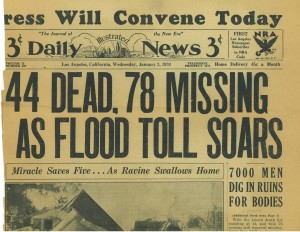The previous three parts of this series showed the consequences of a very particular combination of earth, wind, fire and water in the hills north of downtown Los Angeles. Â The massive devastation caused by the 1933/1934 New Year’s flood was certainly a wake-up call not only for the residents but for local authorities. Well not really. Â The wake-up call should’ve come long before.
The Truth about the Great La Canada Mud Flood! Part 4: We Learned Our Lesson Right Quick!
March 15th, 2010 — History, Mishaps, Places
The Truth about the Great 2010 La Canada Mud Flood! Part 3: New Year’s flood 1934 Unearths Evidence of Monster!
February 26th, 2010 — Mishaps, Places
 Part 1 and Part 2 of this series explain the geography of the Los Angeles basin, including the steep mountains rimming the northern edge of the basin that were pushed up by the action of two tectonic plates meeting along the San Andreas Fault. The articles discussed how the dense chaparral burns fast and hot pushed by the hot winds coming over the mountains from the desert causing the soil to become almost waterproof. All that it takes to set off a huge flood of mud is rain.
Part 1 and Part 2 of this series explain the geography of the Los Angeles basin, including the steep mountains rimming the northern edge of the basin that were pushed up by the action of two tectonic plates meeting along the San Andreas Fault. The articles discussed how the dense chaparral burns fast and hot pushed by the hot winds coming over the mountains from the desert causing the soil to become almost waterproof. All that it takes to set off a huge flood of mud is rain.
The Great Depression that started with the stock market crash in the fall of 1929 hit rock bottom in the spring of 1933. It would be a slow recovery that would not end until the advent of World War II. New Year’s Eve 1933 was still reason for many to celebrate the promise of the New Year. In the little Crescenta-Canada Valley many residents had gone out for the evening. It had been raining for a couple of days, so a warm gathering of friends must’ve sounded good. Unfortunately the loudest noises that evening would not be man-made. Continue reading →
The Truth about the Great 2010 La Canada Mud Flood! Part 2: The Perfect Storm!
February 25th, 2010 — Mishaps, Places
![]() In Part 1: The Lay of the Land, Rusty explained the formation and geography of the greater Los Angeles basin. Rusty’s lived in the northern part of that basin his whole life and has heard about and seen personally what can happen with the Perfect Storm of events.  Here is the whole process laid out for you. Continue reading →
In Part 1: The Lay of the Land, Rusty explained the formation and geography of the greater Los Angeles basin. Rusty’s lived in the northern part of that basin his whole life and has heard about and seen personally what can happen with the Perfect Storm of events.  Here is the whole process laid out for you. Continue reading →
The Truth about the Great 2010 La Canada Mud Flood! Part 1: The Lay of the Land
February 19th, 2010 — Adventure, Mishaps
Part 1: The Lay of the Land
![]() Not all adventures are good clean fun. Some involve going through police barriers to check on your friends to see how they are affected by natural or man-made disasters. Such is the case now, right in the area where Rusty lives.
Not all adventures are good clean fun. Some involve going through police barriers to check on your friends to see how they are affected by natural or man-made disasters. Such is the case now, right in the area where Rusty lives.
In January and February of 2010 people around the country and around the world heard about the devastation caused by water, mud, and debris flows that tossed around cars and two ton concrete barriers like they were a child’s toys. Few people outside of the area really understand how this happens in the relatively dry Southern California Los Angeles basin. Rusty Waters has lived in this area his entire life, looking up at the source of the floods every day. Continue reading →
SEX versus ROMANCE: The Valentine’s Day Survey
February 14th, 2010 — Holidays, Romance, The Sexes
We asked our readers which they would prefer for a Valentine’s Day story from the Adventures of Rusty Waters, SEX or ROMANCE.
The first choice was to find out what happened when three gorgeous women tried to pick up Rusty in a bar. HINT: That was the story you’d get if you voted for SEX.
The second choice was to find out the story of Rusty’s long-lost love. HINT: that was the story you’d get if you voted for ROMANCE. Continue reading →
